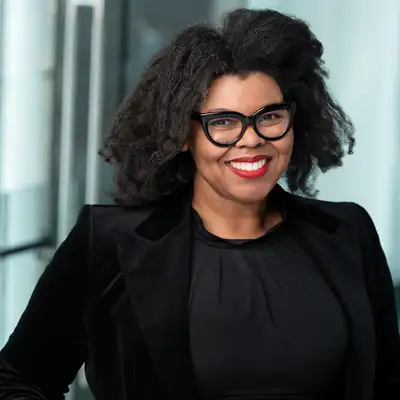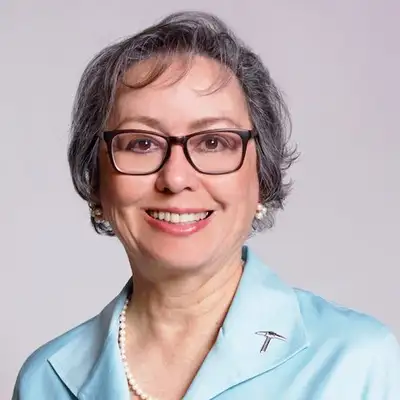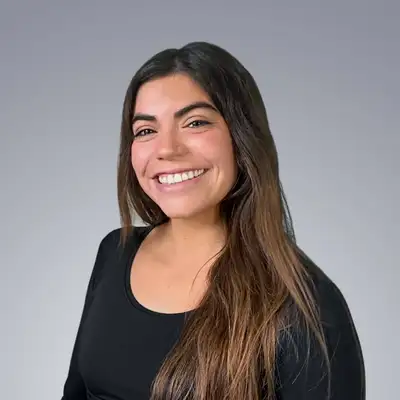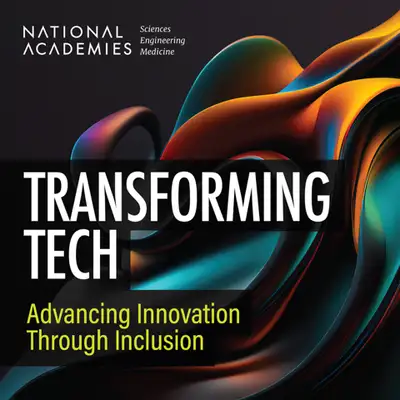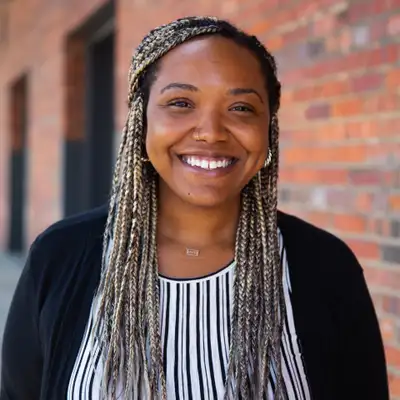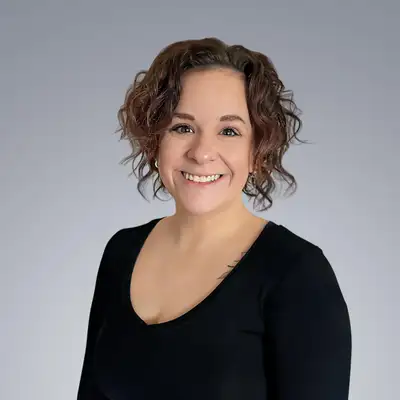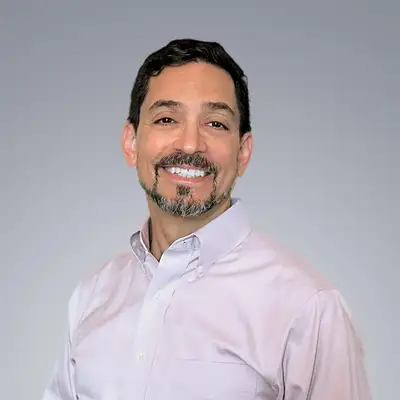Click HERE to view the full consensus study report.
Creators and Guests
What is Transforming Tech: Advancing Innovation Through Inclusion?
You work at a tech company, and you want to do the right thing: You want to hire people from all backgrounds, and you want to make sure your workplace is inclusive. But where do you start? What do you do?
Join entrepreneur, computer scientist, and CEO Jamika Burge in this five-part series from the National Academies of Sciences. Based on research and analysis from the National Academies consensus study “Transforming Trajectories for Women of Color in Tech”, Burge and her guests use design thinking to help engineering and tech companies recruit, retain, and advance women and people of color in their ranks.
Each episode will give you actionable solutions to increase diverse people and perspectives. Inclusion isn’t impossible. Let’s transform tech.
Jamika Burge (00:08):
What do women of color want? To be challenged and rewarded for their work. We want fair compensation, mentoring supports and clear pathways to advanced company. None of these desires are outrageous. They're the same desires as anyone else in tech. It's historical and often implicit bias that prevent us from seeing the similarity of experience. So what do we do about it? Welcome back to Transforming Tech, a five-part series that will help tech companies of every size achieve their diversity and inclusion goals.
Jamika Burge (00:50):
In our last episode, we uncovered some of the reasons that women of color end up unrecruited in tech. In this episode, we're going to share actionable solutions to these problems, research-backed ways that companies can hire more equitably. Equity, it's a word we'll be using and thinking about a lot in this series. Sloan Davis has, I think, one of the best definitions.
Jamika Burge (01:17):
Davis works towards equity at Google in computing research and education by designing and studying interventions that meet the needs of students and educators from historically marginalized groups. You said a word, and I use this word in describing you, that I want us to get the record straight on and that word is equity. And equity is such an important, and for some, a loaded term, that actually means a very specific thing. And by the way, it is not equality. So if you would share with me your thinking about how we should understand equity.
Sloan Davis (01:57):
To ensure that our shared lived experiences as humans with very complex and unique backgrounds are just as successful, fruitful, joyful from one of us to the next regardless of our identities. And some of us start a little closer to the finish line than others, and that requires equity, to me means ensuring that we get everybody starting from the same starting line as best we can.
Jamika Burge (02:23):
Equity is not about giving some people a leg up over others, letting them leapfrog up the corporate ladder regardless of their abilities. Instead, it's about acknowledging that some people start at higher rungs to begin with. To achieve equity, we need to lift everyone up. In our previous episode, Joan Williams, the Sullivan professor of law and founding director of the Center for WorkLife Law at the University of California Hastings Law and the founder of Bias Interrupters, pointed out that often the easiest way to recruit is through referrals, hiring people other people know. Unfortunately, she says...
Joan Williams (03:13):
It has some well often overlooked disadvantages, which is that people's networks tend to be of people who are like them, and so relying heavily on referrals is a fantastic shortcut if your goal is to reproduce the existing demography of your company.
Joan Williams (03:33):
I've never found a company where underrepresented minorities are not sharply penalized by this. It's exacerbated because often the flow of candidates that comes in through referrals kind of gets a lighter look on the ground that they've already kind of been vetted. So in some tent companies, we find that this flow of candidates from referrals is heavily, heavily white men.
Jamika Burge (03:57):
But referrals can be hard to get rid of.
Joan Williams (04:01):
If your goal is to change it, then you should either reconsider referrals. A lot of companies aren't willing to do that because there are some obvious advantages to them.
Jamika Burge (04:12):
Referrals are easy, require no outreach, and often play to people's biases. A referral of someone who went to an existing employee's elite school can feel like a jackpot, but as we discussed in the previous episode, a big name degree doesn't actually mean big name skills. Instead, it can mean someone gets passed up on the recruitment ladder without a second glance, while other candidates, often more experienced candidates who happen to be from marginalized backgrounds get extra scrutiny.
Joan Williams (04:46):
Or at a minimum, what you should do is to separately keep track of the demography of the flow of candidates that's coming in through referrals and the demography of candidates that are coming in through other means, and then compare them.
Joan Williams(05:02):
We actually have 31 experiments in the field now. Bias Interrupters experiments through an alliance with the conference board. And this includes some tech companies, and what we find is that often the flow of candidates that come in through referrals look really different than the flow of candidates that don't.
Jamika Burge (05:25):
This is a key point that's going to come up throughout our series. We need data, data inside our companies to reveal the biases we have and how they appear. Once you see the source of bias, it's a lot easier to know which actions your company needs to take.
Jamika Burge (05:43):
Say you do, as William suggests, your hiring department takes the data and finds that referrals do indeed end up hired more often and also bring less diversity of experience and thought than the applicant pool in general. Your company decides to stop relying on referrals and to really focus on recruiting for more diversity. But where do you do that?
Ann Quiroz Gates (06:06):
I think because it's such a competitive market, if a company truly is focus on let's say more recruitment of women of color, then they need to be going to the institutions that graduate women of color. There's a National Academy report that has come out around minority serving institutions and untapped resource, and that is that the majority of people of color are at MSIs, and it's important that that is a primary area where you should be recruiting.
Jamika Burge (06:47):
That's my friend Ann Quiroz Gates, a professor of computer science at the University of Texas at El Paso. She works on increasing the success of her traditionally marginalized students in tech, both in Academia and beyond. The University of Texas at El Paso is proud to be America's leading Hispanic-serving university, making it an MSI or minority serving institution. As part of the computer science department, Quiroz Gates mentors many young women of color looking to get into technology. Part of her success has come from partnering with tech companies who are looking for new employees.
Ann Quiroz Gates (07:25):
You have to build relationships with the chair, with the faculty, with the student organizations.
Jamika Burge (07:33):
Partnering with institutions can truly help recruitment. In Transforming Trajectories for Women of Color in Tech, the report emphasized several companies that have worked to develop meaningful relationships with minority serving institutions. For example, Lockheed Martin Corporation launched an initiative in 2016 in which they partner with historically black colleges and universities as well as Hispanic-serving institutions.
Jamika Burge (07:58):
They provide funding that supports science, technology, engineering, and math research for undergraduates. Along with the funding, a senior leader from the company serves as an executive sponsor to show that the company means business and to help students connect with members of the company that might sponsor them in the future. The efforts have led to an increase in the number of women of color hired at the company. Sloan Davis works with a similar program.
Sloan Davis (08:27):
So we have a variety of ways of doing that, whether that's exploreCSR, which provides funding to faculty to host initiatives on campus that increase exposure, awareness, and practice in computing research for students from historically marginalized groups.
Sloan Davis (08:43):
We have a computer science research mentorship program that matches students from historically marginalized groups with active researchers at Google to give more insight into the career path, how to advance from where they are today to where they want to be in computing research.
Jamika Burge (08:59):
But setting up a mentoring program alone doesn't cut it. The company has to evaluate how that program is helping its students.
Sloan Davis (09:08):
We evaluate our students on six demographic cohorts. And so the first is all students, everybody who participated in the program, and that was around 400 students across two cycles of the program. Then we look at any student who identifies with one or multiple historically marginalized gender, race, ethnicity, or ability group.
Sloan Davis (09:32):
Then we look at all students who identify as black, indigenous and Latinx, students who identify as black, indigenous Latinx and non-binary or women. Then we look at our first-generation college students, and then we look at our students with disabilities. Across all of those groups, we are super excited to see that there was positive statistically significant change on all four of those evaluation criteria that we discussed earlier across all demographic subgroups.
Jamika Burge (10:02):
But the data wasn't all good news.
Sloan Davis (10:05):
We were also asking students, "Which steps do you plan to take After participating in this program?" We found that students who identify as black, indigenous and Latinx, regardless of gender identity were less likely to say that they were planning to submit research to a conference.
Jamika Burge (10:23):
But Davis didn't see this as a sign of failure in the program. Instead, she says she saw it as an opportunity to see what parts of the program could be changed or improved. How could the program help make women of color feel more comfortable submitting their research to a conference?
Sloan Davis (10:41):
So what might we do within the program? How might we coach our mentors to talk more about the conference submission process, the life cycle of designing research with the intent for publication, not specifically based on the identity that they assume their students have, but to describe that to all students more explicitly?
Jamika Burge (11:04):
This is what equity is about, not giving some people advantages, but making sure that we are all lined up on the same starting line and all have the same chance to succeed in the race. These relationships can't just involve a company waltzing in and funding an initiative. Like any new initiative or design, Gates says research is key.
Ann Quiroz Gates (11:27):
You have to build relationships. You have to understand where should I be going and create a relationship before you jump all in. Is this the right place I should be recruiting from? It may be, it may not be. But I think again, it goes back to building these relationships, starting out slow, if you will.
Ann Quiroz Gates (11:49):
You don't want to put all of your resources into a particular university and it doesn't work out. But you have to build relationships with the chair, with the faculty, with the student organizations, because that's going to tell you a lot about how the university, how the department operates. We have found, especially companies are recruiting people of color and a particular woman that they really need to understand the context of the university at which they're recruiting. There really needs to be a focus on how the company supports, especially women of color. Right?
Jamika Burge (12:33):
And of course, not every company has the resources to fund university research, but it doesn't cost nearly so much to show up and recruit for job fairs at minority serving institutions or at conferences for women of color. The trick though is to work to make sure recruits can see themselves at your company, which means seeing employees that might share some of their identities. A recruiting team with traditionally marginalized members can be the first step to making a workforce more inclusive.
Ann Quiroz Gates (13:03):
I think a lot of the companies that come to UTEP are now bringing recruiters who represent the type of people that they want to recruit. So we're seeing more Latinas coming in who can then speak to the students around their work experiences and recruit them.
Jamika Burge (13:26):
Coming to recruit and forming partnerships can help, but of course, companies aren't always recruiting right out of college. And even when they do, the language in the job ad matters. A lot of job ads in tech lean into words like competitive or assertive, words that emphasize the hustle, rise and grind of startups. We'll talk more about the rise and grind issue in later episodes, but words like that tend to be read as more masculine, and they're also not qualities that people actually need to be successful in tech.
Jamika Burge (14:01):
Another issue is degree inflation. Maybe you've seen the jokes going around on social media, "Entry level position requires 10 years of experience and two master's degrees." Well, that's a joke. It's also a sign of some of the degree inflation that appears in job ads. When putting together a job ad, ask yourself, "What skills do I need? Do those skills require a master's degree, a bachelor's degree, any degree at all?"
Joan Williams (14:30):
You need to pre-commit to what you're looking for in a given position. You need to ensure that resumes are evaluated based on those specific skills that you're looking for. You need to ensure that, so you're ranking the candidate's skill by every candidate according to in this rubric, skill by skill. And then you need to make sure the resumes are being graded on the same scale by making it very clear what the scale is.
Joan Williams (15:01):
Not hard, but often overlooked. And then once you have that list of what you're looking for, you need to keep track of when requirements are waived because the research strongly shows that objective requirements are often waived for in groups. Objective rules are often applied rigorously to out groups, but very leniently to ingroups.
Jamika Burge (15:25):
That's Williams again. And when she says in groups, what she means is that people make exceptions for people like them. Maybe for people who applied because of a referral or people who might remind a hiring manager of themselves when they were young. It's an understandable desire, but it's also not going to help a company increase its diversity.
Jamika Burge (15:46):
In the National Academies report on Women of Color in Tech, there is an example from IBM, which has emphasized in approach to calls skills over degrees. They are using the approach to open avenues and detect for women with non-tech backgrounds or who may have been absent from the field. This is one way that companies fight back against the biases they might have around women with children and the breaks that caregivers have to take in their careers.
Joan Williams (16:13):
Don't count resume gaps as an automatic negative and don't count gaps for being fun-employed differently than gaps where someone has taken time out for a child, which is very common. Taking time out to be fun-employed is considered cool, and taking time out for a child is often seen as lack of commitment. So that's important from a gender front.
Jamika Burge (16:35):
There's also the issue of culture. In our previous episode, we put it out that women of color might not feel welcomed without support. And if a job application process focuses a lot on fitting into an existing culture and the culture is mostly white men, any job ad begins to lose its appeal. Reducing the importance of culture fit in a job ad could make more women of color feel like they see themselves at your company.
Jamika Burge (17:03):
Even when referrals are gone and job ads are fixed, there's still the issue of relying on a few high-level institutions. Partnering with historically black colleges and universities or HBCUs can partially address this, but even so, it's hard to stop the flash of recognition and positive impression when you see those special letters, MIT, Caltech, Harvard.
Jamika Burge (17:29):
As the National Academies report notes, when companies use college rankings to inform hiring decisions, they give preference to elite universities and they disadvantage universities that graduate more minority students. One way to get at this, Williams notes, is with blinded resumes.
Joan Williams (17:48):
Blind recruitment, it can be very effective. It's just taking the names and other identifying racial and gender information off the resumes. And so some companies have said, "Look, we are making a special effort to reach out to women engineers, for example, or people of color, and so we don't want to blind the resumes because that doesn't enable us to do that." But the research shows that, I mean, the famous study was actually a study of women hired by orchestras, and when orchestras began to hold auditions behind screens, that's the only way that women started to appear in national orchestras. So it can be very powerful.
Jamika Burge (18:37):
Another often overlooked tool is the structured interview. A free flowing conversational interview might feel like a more comfortable hiring process to those doing the hiring, but it also allows hiring managers to more easily let requirements slide for potential employees who look like them. Think about it. If you were the one being interviewed, would you want to know you might get beaten out of a job even though you're the most qualified person there because someone else just vibed better with the hiring manager?
Jamika Burge (19:10):
A structured interview where everyone is asked the same set of questions levels the playing field for everyone. It makes it easier to compare answers and skills and prevents the person doing the hiring from giving in to their own biases. Of course, not every method of increasing diversity in recruitment is going to work for every company. Many companies can afford mentorship programs or might not have a hiring team with traditionally underrepresented members, but every company has some step they can take to improve. The important thing is to determine which steps to take and take them with care and intention.
Sloan Davis (19:55):
Equity is not going to happen organically. We're not going to turn around one day and say, "Huh, I don't know when it happened, but suddenly, our rate of representation of women or native and indigenous employees is on par with the representation in the general populace. How did that happen?" It's never going to work that way. It requires being incredibly intentional. And it's also not just going to happen through good intentions.
Sloan Davis (20:22):
We're going to get it wrong. We're going to make mistakes. But if we don't have the frameworks in place to understand, set our hypothesis at the beginning, run our tests, evaluate our data, and draw a conclusion about whether that intervention, that test was successful or not in affecting the change that we want to see.
Jamika Burge (20:40):
Intention also requires motivation and drive. Often that drive needs to come from the top.
Ann Quiroz Gates (20:48):
I think at an organization, leaders CEOs, people in the C-suite really need to emphasize the importance and the value that is brought by bringing in diversity as they are for the products that they develop, the marketing that they do. And so it's a change in mindset, and it comes from the top, and it comes from changing the mindset.
Jamika Burge (21:14):
None of these changes are easy. Employees, managers, and leaders will need to keep working every day to make sure the right practices are being implemented. The first step to that? Well, you can start by sharing this podcast. Here are our takeaways. First, companies can build partnerships with minority serving institutions and conferences for women of color. They can also go recruit at those institutions and conferences to diversify their applicant pool.
Jamika Burge (21:43):
Second, companies can collect data on their recruitment efforts, finding out who they recruit, where they come from, and how far along people get in the process. They can place emphasis on skills over degrees and be clear in their ads about what skills are needed, not just relying on a degree to stand in for experience. Third, companies can blind applicant resumes and conduct structured interviews to make sure that everyone who applies and is interviewed has the same chance to shine.
Jamika Burge (22:17):
Fourth and finally, companies can be intentional, thinking hard and clearly about the steps they need to take to integrate, not just increase diversity in their hiring, and make sure they have the motivation and follow-through to make those actions happen. Great, you've made your hiring process more inclusive. Now, how do you retain and advance the talent that you've hired? That's our topic for next time. Stay tuned.
Jamika Burge (22:56):
This podcast, Transforming Tech, has been a production of the National Academies of Science, Engineering and Medicine, the National Academies Press and Voxtopica Productions. Its contents are based on the National Academies 2022 Consensus Study Report, Transforming Trajectories for Women of Color in Tech, a publication of the committee on Addressing the Under-representation of Women of Color in Tech, the committee on Women in Science, Engineering and Medicine, and Policy and Global Affairs.
Jamika Burge (23:30):
This podcast was developed, written, and created by Voxtopica Productions. Our executive producer is Richard Fawal. Our producer is Laura Krebs. Direction and script writing by Bethany Brookshire, with help from Cassidy Butler. Technical Operations from Ismael Balderas Wong and Reese Clutter. Project assistance from Alya Fawal. I'm Jamika Burge.
VO (23:59):
Voxtopica.
